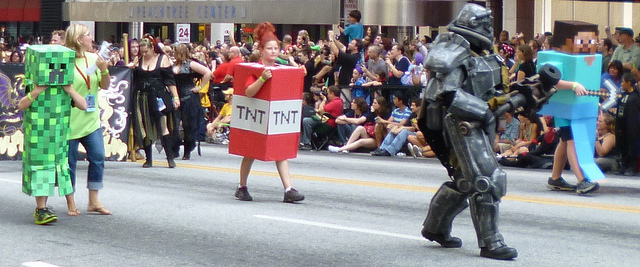“I’m a YouTuber!” my six-year-old cousin recently proclaimed. What he meant was that his love of Minecraft means he watches a lot of videos of other people playing Minecraft. Watching these videos, called “Let’s Plays,” has introduced him to YouTube personalities like UK-based DanTDM (his favorite), whose YouTube channel, The Diamond Minecart, has 9 million subscribers. Nine million.
DanTDM and his Diamond Minecart are not anomalies. Minecraft has taken over social media, permeated homes and even schools, and generated millions of dollars in game sales and related merchandise. The game itself, along with its developer, Mojang, sold for $2.5 billion to Microsoft in late 2014. Two and a half billion.
The game’s undeniable popularity has a lot of people scratching their heads. So seriously, what’s so great about Minecraft?
Kids love Minecraft for the same basic reasons they love any video game — it excites and challenges them. But as a “sandbox” game, in perhaps the truest sense of the term, Minecraft gives them a unique control over the game world and what they create within it. In Minecraft, kids can do whatever they want, however they want.
When kids play Minecraft, they exercise major thinking skills like focus, planning, flexibility, organization, and time management. Additionally, when they play the game online or engage with others on social media, they practice valuable skills like self-awareness, which includes metacognition (thinking about one’s own thought process) and empathy.

A screenshot from a LearningWorks for Kids’ Let’s Play video
The thinking skill exercise and social exposure kids get when they play Minecraft means the game is particularly well-suited for kids affected by ADHD and autism. For some, that in-game social acceptance is a unique experience, and whole communities have sprung up within the world of Minecraft. AutCraft, for instance, is a Minecraft server established by Stuart Duncan, a father with asperger’s who desired a safe space to play for himself, his child (also on the spectrum), and others with autism. Many parents appreciate Minecraft for just this reason; the ability to make private servers and establish communities means kids are able to get an online experience that parents don’t really have to worry about.
And teachers love it because kids love it. Minecraft is so widely played by kids that it lends itself to teaching them a number of subjects. Educators have been using Minecraft as a teaching tool for a while now — MinecraftEdu, a classroom-tailored version of the game, was also recently acquired by Microsoft and is being reformulated and rebranded as Minecraft: Education Edition — used for everything from computer science to creative writing. And because of its mass popularity, Minecraft is also uniquely positioned to help teach kids digital literacy skills (like writing in online environments and programming) and digital citizenship skills (how to be part of a community, even when you aren’t face-to-face), which are necessary for success in the 21st century.
There you have it. Even if pixelated pork chops and pickaxes perplex you, there is still plenty to appreciate about Minecraft. We write a lot about Minecraft, so a quick search on our blog will bring up plenty to read, including articles like “Is Minecraft Addiction Possible?” and “Why I Use Minecraft As a Teaching Tool.” For more on the game and how to play with and talk to your child about it, see our Minecraft Playbook. You should also check out our YouTube Let’s Play channel, hosted by our Let’s Play editor Ryan, to find tons of videos featuring some of the most popular video games (including Minecraft, of course) kids are playing right now.
Featured image: Flickr user James Emery




